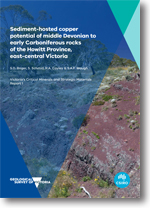VCMSM Report 1 - Sediment-hosted copper potential of middle Devonian to early Carboniferous rocks of the Howitt Province, east-central Victoria.
 |
| |||||
Product description:Executive Summary:Sediment-hosted copper mineralisation occurs widely in the middle Devonian to early Carboniferous fluviatile sedimentary rocks of east-central and eastern Victoria. To characterise the form and distribution of copper mineralisation and the host stratigraphy, the Commonwealth Scientific and Industrial Research Organisation undertook HyLogger infrared reflective spectroscopy, Minalyze X-ray spectroscopy, Maia X-ray fluorescence spectroscopy, petrography and back-scattered electron microscopy on drill core from four historical diamond drill holes in the Mansfield Synclinorium. The Mansfield Synclinorium is the northernmost and best studied synclinoria of the Howitt Province; it is also hosts the most widespread examples of sediment-host copper mineralisation presently known in Victoria. In the Mansfield Synclinorium, copper occurrences are most widely found in the early Carboniferous Snowy Plains Formation, which divides informally into a lower sandstone formation and an upper siltstone formation. The lower sandstone formation is comprised of an intercalated sequence of texturally immature channel belt and crevasse splay sandstone and floodplain-playa mudstone. Copper occurrences in the lower sandstone formation are of redbed type and hosted by lenticular horizons of channel belt sandstone. Malachite is the dominant copper mineral identified to date, and is found closely associated with fossil plant debris. This association suggests that carbon rather than sulphur may have played a key role in the reduction of copper and the formation of mineralisation. The upper siltstone formation, by comparison, is comprised of a lithologically monotonous succession dominated by purple siltstone and mudstone, with less common intercalated layers of sandstone, and rare beds of dolomitic mudstone and siltstone. These rocks mostly represent low-energy, fluviatile floodplain and/or lacustrine deposits with the uncommon dolostones precipitating in an evaporative hypersaline environment. The depositional setting of the dolostones is likely represented by either an ephemeral playa lake, or a coastal sabkha or lagoon. The dolostone layers host a number of reduced faciestype copper occurrences comprised of disseminated copper sulphide (e.g. chalcopyrite, bornite, digenite and covellite) and carbonate minerals that, although typically occurring in intervals less than 0.5m thick, show kilometre scale along-strike continuity. The formation of these copper minerals and their association with dolostone, reflects the availability of dissolved sulphate during dolostone deposition. The sulphate, concentrated either via evaporation from terrestrial sources or derived from marine ground or surface waters and/or from marine aerosols, was essential for the bacterially mediated precipitation of the dolomite and for the formation of pre-mineralisation sulphides. These sulphides were then responsible for the precipitation of copper during basin evolution and sediment diagenesis. The reduced facies-type copper mineralisation observed in the upper siltstone formation is considered the most prospective given this style of mineralisation has the potential to form laterally extensive sheet-like ore bodies. By analogy with the exposed areas of reduced facies-type copper mineralisation observed in the Mansfield Synclinorium, further areas of copper enrichment are considered likely to be found in association with dolostone and the distinctive evaporative depositional environment that these rocks imply. Crosssectional exposures of mineralised rocks are, however, likely be narrow when compared to the potential plan-view extent of mineralisation. The mineralised stratigraphy exposed in the Mansfield Synclinorium occurs in all Howitt Province erosional remnants, including the Mount Typo, Macalister and Avon synclinoria. Equivalent rocks are also likely present in the sub-surface of the Ovens Graben. These regions remain underexplored for sediment-hosted copper. Bibliographic Reference: Boger, S.D., Schmid, S., Cayley, R.A. & Waugh, S.A.F., 2024. Sediment-hosted copper potential of middle Devonian to early Carboniferous rocks of the Howitt Province, east-central Victoria. Victoria's Critical Minerals and Strategic Materials Report 1. Geological Survey of Victoria, Department of Energy, Environment and Climate Action, Melbourne. 36 pp. Download: The downloadable version of this report is supplied as (PDF 7 MB), Attachment A1 data (ZIP 33 MB), Attachment A2 data (ZIP 241 MB), Attachment A3 (ODS 260 KB), Attachment A4 data (ZIP 704 KB), Attachment A5 data (ZIP 520 MB), Attachment A6 data (ZIP 4.5 GB) & Attachment A7 (ODS 31 KB). | ||||||

